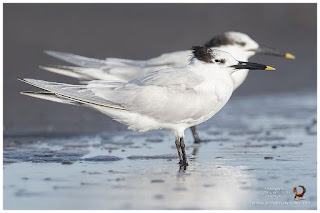Our tour continued on a second day. We were supposed to leave Boquete very early in the morning along our Chiriquí correspondent, Rafael, but the open beer made havoc the night before. Our main photographer, Miguel, was having a hangover and Rafael didn't wake up. With the incomplete team we headed to Charco Azul, a vicinity of Puerto Armuelles in Punta Burica, close to the Costa Rican border.
We had previously arranged permits to enter private grounds in search of several specialties of the area like Riverside Wren, Baird's Trogon, Black-hooded Antshrike, Tawny-winged Woodcreeper, Fiery-billed Aracari, Golden-naped Woodpecker, Orange-collared Manakin, Fer-de-lance and Boa snakes, Squirrel Monkeys and Howler Monkeys. We also hired a local resident who would guide us through the woods and rivers.
We were a bit late and the local "guide" arrived late to the meeting place, later we understood why: he was drunk. While we waited for him, we were able to see two species of hawks and found one of our targets which was intensively calling.
Broad-winged Hawk (Buteo platypterus) taking a sunbath at sunrise
Roadside Hawk (Rupornis magnirostris)
Black-hooded Antshrike (Thamnophilus bridgesi) is confined to the Pacific slope of Costa Rica and adjacent western Panama. Its natural habitats are subtropical or tropical moist lowland forests, subtropical or tropical mangrove forests, and heavily degraded former forest. Males are largely deep black, becoming marginally paler over the ventral region, with three rows of well-marked white spots on the wings, while females are principally brown, with a contrasting black tail, equally prominent white wing-spots, and a narrowly but obviously white-streaked head and underparts.
In Panama is a common species found in western Pacific slope but the species has apparently disappeared from many areas as a result of deforestation, yet remains reasonably common in neighboring Costa Rica.
As we entered into the woods we saw more black-hooded antshrikes, and lots of riverside wrens, and orange-collared manakins at a lek but making pictures was very difficult.
Black-hooded Antshrike (Thamnophilus bridgesi) - female and male
Finally we had the opportunity with a riverside wren that was not shy and was so close that almost didn't fit into the picture frame.
Riverside Wren (Cantorchilus semibadius) is confined to the Pacific slope from central Costa Rica to western Panama. Its natural habitat is subtropical or tropical moist lowland forests, where it is generally common but not necessarily easily seen, on account of its usually skulking behavior and liking for areas of dense vegetation. The species is found from sea level to about 1200 m. While the upperparts are principally chestnut-colored, below this wren is whitish heavily barred blackish, and the wing coverts and tail are also barred the same color.

In the forest we were also able to see a pair of White-whiskered Puffbirds (Malacoptila panamensis) and later on the forest edge a Gartered Trogon and Red-crowned Woodpeckers nesting. The day was very sunny and hot, monkeys were not around, and we were not able to spot other species.
Therefore, we decided to call it quits and move to another place. We had lunch in David and then were invited to spend the rest of the day and night at Miguel's cousin's apartment at La Barqueta beach. In the afternoon, once the sun was about to set we resumed photography duties with coastal birds. There we find a flock of gulls and terns just hanging around, and sanderlings foraging voraciously. We accepted the challenge of making good pictures of the running sanderlings.
Laughing Gull (Leucophaeus atricilla)
Sandwich Tern (Thalasseus sandvicensis)
Royal Tern (Thalasseus maximus) is found in Europe, Africa, the Americas, and the Caribbean islands. The royal tern lives on the
coast and is only found near salt water. They tend to feed near the shore, close to the beach or in backwater bays. This is a large tern, second only to Caspian Tern. The royal tern has an
orange-red bill (from yellow to reddish),
pale grey upperparts and
white underparts. Its
legs are black. In
winter, the black cap becomes patchy.
Sanderling (Calidris alba) is a small
wading bird of the
sandpipers family. It breeds in Arctic polar circle, and is a long-distance
migrant, wintering south to Central and South America, South Europe, Africa, and Australia. It is highly gregarious in winter, sometimes forming large flocks on coastal mudflats or
sandy beaches, running along with a characteristic "bicycling" action of its legs, stopping frequently to
pick small food items. It eats small crabs and other small invertebrates.
It is somewhat unlike other sandpipers in appearance, during the winter the bird is very pale, almost white apart from a dark shoulder patch. This is the source of the specific name, alba, which is the Latin for "white". Later in the summer, the face and throat become brick-red.
End of the report.
























Comments
Post a Comment